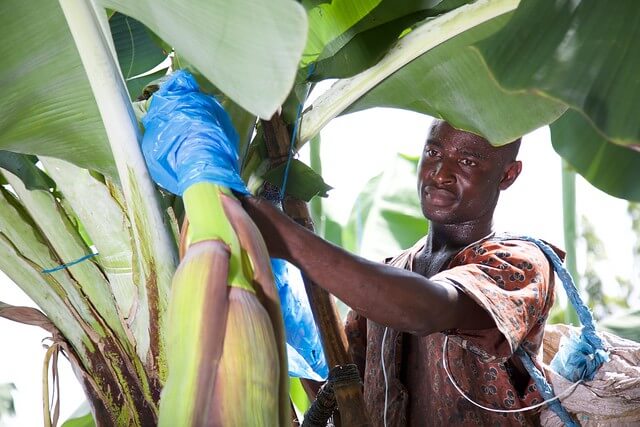
Latin America …
dominates the global banana export economy. The fruit represents an important source of income for these countries. Latin American countries export to Europe, North America, Russia and, most recently, China. The majority of Europe’s bananas and pineapples come from countries in Latin America, like Ecuador which is the world’s largest banana exporter, Costa Rica which is the world’s largest pineapple exporter, and Colombia. In recent years, Guatemala has expanded rapidly to overtake Colombia in export volumes. It is established as far and away the largest source of bananas for North America, with nearly 40% of US imports.
Large scale production
Typically, Central American bananas are grown on large-scale monoculture plantations covering several hundred hetares each. This form of production uses high levels of chemical inputs to increase crop yield. Labour conditions can be very poor, with workers required to work long hours for wages that are insufficient to meet basic needs. Rights of free association and collective bargaining are often denied and ‘union-busting’ is common in the region. The large plantations are also frequently responsible for damaging environmental impacts.
Ecuador, Colombia and Peru are the only countries among the major Latin American exporters that still have small banana farmers exporting alongside the large-scale plantations. Across South America, and especially in Peru, some 10,000 small farmers sell to the world market, often thanks to organic and Fairtrade certification. In Ecuador, the smallholders often fulfil a kind of buffer function for the big banana exporters: they buy from small producers when the demand on the international market is high, but if there is less demand, the small producers are often forced to sell their produce at a loss.

Caribbean …
bananas are often produced by small family owned farms and medium-scale plantations using more sustainable methods of production than in the large monoculture plantations in Latin America. The largest Caribbean exporting country, the Dominican Republic, has a mix of small farmers, medium-scale and even a handful of large-scale plantations, although around two thirds are produced organically.
The banana trade has been crucial to the economies of the Caribbean region. Banana plantations were established over 60 years ago by the British. However, over the past twenty five years, the Windward Islands’ share of the UK banana market has fallen from over half to just 1%, and the number of farmers has dropped from 27,000 to just a few hundred exporting from St Lucia. The competition with large-scale plantations producing ‘cheap’ bananas in Latin America, coupled with a series of violent hurricanes, has had serious social and economic consequences for the Windward Islands.
Although most Windwards bananas are produced under Fairtrade conditions, the volumes are now too low to have the same positive effect on rural communities that they had for the first decade of the 21st century.
In Jamaica, a series of natural disasters put paid to the export industry and farmers now produce for a local processing industry.
The Dominican Republic industry has more than doubled in size over the last decade and now employs over 30,000 people, the majority of whom are migrants from neighbouring Haiti.

Africa …
Almost all African countries produce a significant amount of bananas and plantains, but only a few actually export fresh dessert bananas. West and Central African countries – Côte d’Ivoire, Ghana and Cameroon – produce nearly all of Africa’s banana exports. Production in this region has grown rapidly over the past 20 years. The vast majority of these bananas are sold in Europe, mainly in France and the UK.
In 2005, the French Compagnie Fruitière invested in a large new plantation in Ghana, alongside an independent Fairtrade plantation that was already in operation. They have recently been joined by a third (Kuwaiti) company. Virtually all banana workers in Ghana belong to a trade union and collective bargaining agreements are in place in both companies.
In Côte d’Ivoire (the Ivory Coast), large and medium-scale plantations are in the hands of either the French multinational Compagnie Fruitière or other French Caribbean and Belgian companies.
In both these countries, the trade unions have relatively weak and divided, but have established coordinating platforms in the biggest companies. The unions do not however yet bargain directly with the banana companies, as wages are determined at the level of the whole agricultural sector. As a result, the gap between what many workers earn and a living wage is substantial.
In Cameroon, three large-scale plantations are owned by the State (currently not exporting because of the crisis in the Anglophone Southwest region), Compagnie Frutière and a smaller national company.















